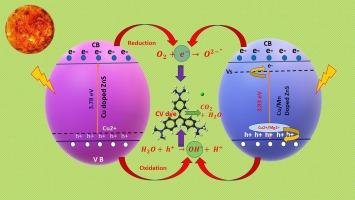生物相容性锰铜双掺杂 ZnS 纳米片在阳光照射下增强光催化活性,用于废水处理,并嵌入 PVA 聚合物以实现重复使用
IF 3.9
3区 材料科学
Q2 MATERIALS SCIENCE, MULTIDISCIPLINARY
引用次数: 0
摘要
本研究通过共沉淀法合成了掺锰和掺铜的 ZnS 纳米片,重点研究了它们的结构、光学、光催化和溶血特性。XRD 分析证实其为立方结构,晶体尺寸随着掺杂水平的增加而减小。TEM 鉴定出了皱褶纳米片,而紫外可见光谱测量出 ZM1、ZM2、ZM3 和 ZM4 样品的带隙分别为 3.98、3.78、3.93 和 4.09 eV。ZM3 纳米片具有优异的光催化性能,在阳光下 110 分钟内实现了 99% 的染料降解。动力学分析表明,ZM3 的速率常数为 46.91 × 10-3 min-1。当将 ZM3 纳米片嵌入 PVA 聚合物膜中时,降解效率达到 95%,并具有良好的可重复使用性。该研究还探讨了降解机制、剂量和染料变化的影响以及对人类红细胞的溶血活性,从而全面了解了这些掺杂 ZnS 纳米片。本文章由计算机程序翻译,如有差异,请以英文原文为准。

Biocompatible Mn and Cu dual-doped ZnS nanosheets for enhanced the photocatalytic activity under sunlight irradiation for wastewater treatment and embedded with PVA polymer for reusability
This study investigates the synthesis of Mn and Cu-doped ZnS nanosheets via the coprecipitation method, focusing on their structural, optical, photocatalytic, and hemolytic properties. XRD analysis confirmed a cubic structure, with crystallite size decreasing as doping levels increased. TEM identified crumpled nanosheets, while UV–Vis spectroscopy measured bandgaps of 3.98, 3.78, 3.93, and 4.09 eV for the ZM1, ZM2, ZM3, and ZM4 samples, respectively. The ZM3 nanosheets exhibited superior photocatalytic performance, achieving 99 % dye degradation in 110 min under sunlight. Kinetic analysis showed a rate constant of 46.91 × 10−3 min−1 for ZM3. When embedded in a PVA polymer membrane, the ZM3 nanosheets demonstrated 95 % degradation efficiency and excellent reusability. The study also explored the degradation mechanism, effects of dosage and dye variation, and hemolytic activity on human red blood cells, providing a comprehensive understanding of these doped ZnS nanosheets.
求助全文
通过发布文献求助,成功后即可免费获取论文全文。
去求助
来源期刊

Materials Science and Engineering: B
工程技术-材料科学:综合
CiteScore
5.60
自引率
2.80%
发文量
481
审稿时长
3.5 months
期刊介绍:
The journal provides an international medium for the publication of theoretical and experimental studies and reviews related to the electronic, electrochemical, ionic, magnetic, optical, and biosensing properties of solid state materials in bulk, thin film and particulate forms. Papers dealing with synthesis, processing, characterization, structure, physical properties and computational aspects of nano-crystalline, crystalline, amorphous and glassy forms of ceramics, semiconductors, layered insertion compounds, low-dimensional compounds and systems, fast-ion conductors, polymers and dielectrics are viewed as suitable for publication. Articles focused on nano-structured aspects of these advanced solid-state materials will also be considered suitable.
 求助内容:
求助内容: 应助结果提醒方式:
应助结果提醒方式:


